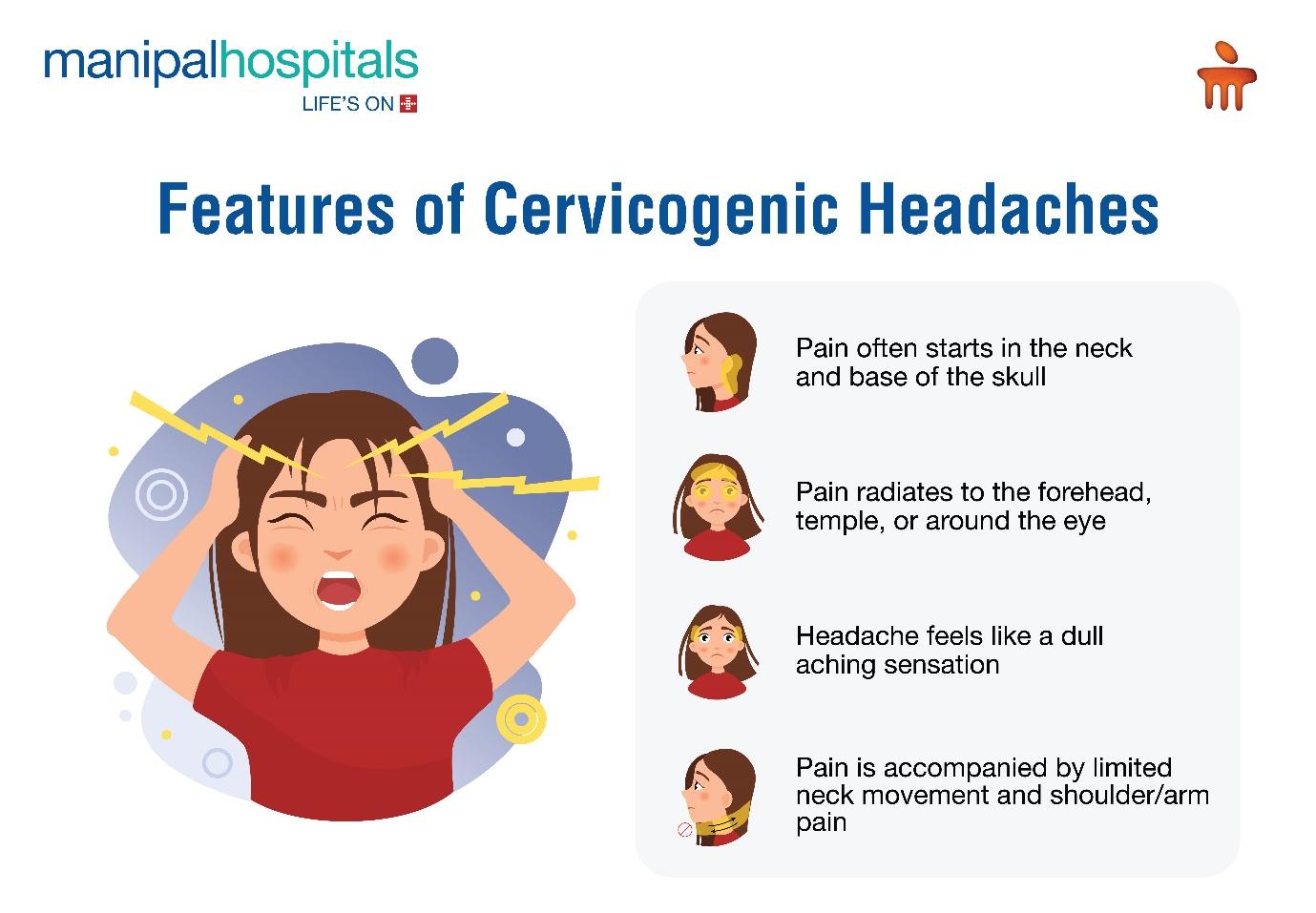
Everyone experiences headaches. You might battle a one-sided migraine that leaves you debilitated or endure a stress-induced tension headache that wraps around your head like a tight band. Sometimes you may even experience a cervicogenic headache where the pain begins in your neck and crawls up behind your eyes.
Cervicogenic headaches are common, chronic, recurrent headaches due to sharp neck movements. While they are similar to migraines or tension headaches, cervicogenic headaches originate in your neck (cervical spine) with pain and limited mobility in the neck.
Synopsis
How are Cervicogenic Headaches Different?
In cervicogenic headache, the pain starts in the neck and is felt in the face and head. Certain neck movements or sustained postures can trigger them. Here are some key features of cervicogenic headaches:

-
The pain typically starts in the neck, and base of the skull, and radiates to the forehead, temple, or around the eye.
-
Cervicogenic headaches appear as a dull, aching, and non-throbbing sensation.
-
Neck stiffness, limited range of motion in the neck, pain in the shoulder or arm on the same side, and sensitivity to light or sound (less common than in migraines) accompany these pains.
What Causes Cervicogenic Headaches?
Understanding the causes of cervicogenic headaches is crucial for effective treatment. These headaches arise from problems in the upper cervical spine, specifically the top three vertebrae (C1-C3), and the surrounding muscles, ligaments, and joints. Several factors affect this region:
-
Degenerative conditions like osteoarthritis
-
Herniated or bulging disc in the neck
-
Tight or overworked neck muscles
-
Sports injury, or wear and tear
-
Compressed or irritated spinal nerves
-
Improper posture (cervical protraction)
-
Falling asleep in awkward positions
Diagnosis Cervicogenic Headaches
The doctor will first perform a physical examination by applying pressure to different parts of the neck or base of the head to track the pain’s origins and trigger spots. Your doctor may also assess your neck mobility and positioning. And if any of the positions provoke pain from neck to head, the headache is cervicogenic. The doctor may order imaging tests (X-rays, CT scans, or MRIs) to rule out other conditions.
Cervicogenic Headache Treatment
There are several cervicogenic headache relief options to help you manage the pain:
-
Physical Therapy: helps strengthen neck muscles, improve posture, and restore range of motion.
-
Medications: Over-the-counter pain relievers (like ibuprofen or naproxen) can provide temporary relief. In some cases, stronger pain medications or muscle relaxants may be prescribed.
-
Injections: Trigger point injections or nerve blocks can help alleviate pain and inflammation in specific areas.
-
Lifestyle Modifications: Improving posture, taking regular breaks from desk work, and managing stress can help manage cervicogenic headaches.
-
Alternative Therapies: Acupuncture, massage, and yoga may provide some relief for some individuals.
-
Chiropractic Care: Some patients find relief through chiropractic adjustments, which can help realign the cervical spine and reduce nerve irritation.
-
Cognitive Behavioural Therapy (CBT): While not a direct cure for cervicogenic headaches, CBT can help patients manage pain and develop coping strategies.
How to Prevent Cervicogenic Headaches?
Preventing cervicogenic headaches is often easier than treating them. Here are some tips:
-
Practice good posture, especially when working at a desk
-
Take frequent breaks to stretch and move your neck
-
Use ergonomic equipment at work and home
-
Strengthen your neck and upper back muscles through targeted exercises
-
Use the correct pillow for sleeping
-
Manage stress through relaxation techniques or meditation
Conclusion
Cervicogenic headaches can significantly impact your quality of life. If you're experiencing persistent neck pain and headaches, don't hesitate to consult with our neurologist at Manipal Hospitals Goa. With a proper diagnosis and a comprehensive treatment approach, you can find relief and regain control over your pain.
FAQ's
Cervicogenic headaches typically start in the neck and spread upward and get worse with neck movement and it does not cause nausea or sensitivity to light/sound. Migraines often occur in the head and are accompanied by nausea and light/sound sensitivity.
These headaches can last hours to days. Without treatment, they may become chronic. Some people experience continuous pain with fluctuating intensity, while others have episodes with pain-free periods in between.
Yes. Poor posture, especially "forward head posture" from looking at phones or computers, puts extra strain on your neck muscles and joints. This can irritate nerves and trigger cervicogenic headaches.
Yes, indirectly. Stress often causes muscle tension, particularly in the neck and shoulders. This tension can aggravate the structures that cause cervicogenic headaches. Stress management techniques can be an important part of treatment.
Surgery is rarely needed and is typically only considered if a clear structural problem or nerve compression is causing the headaches.
While some acute episodes might resolve spontaneously, chronic cervicogenic headaches typically require treatment to address the underlying cause. Without proper treatment, they may become more frequent or severe.





















 4 Min Read
4 Min Read


















